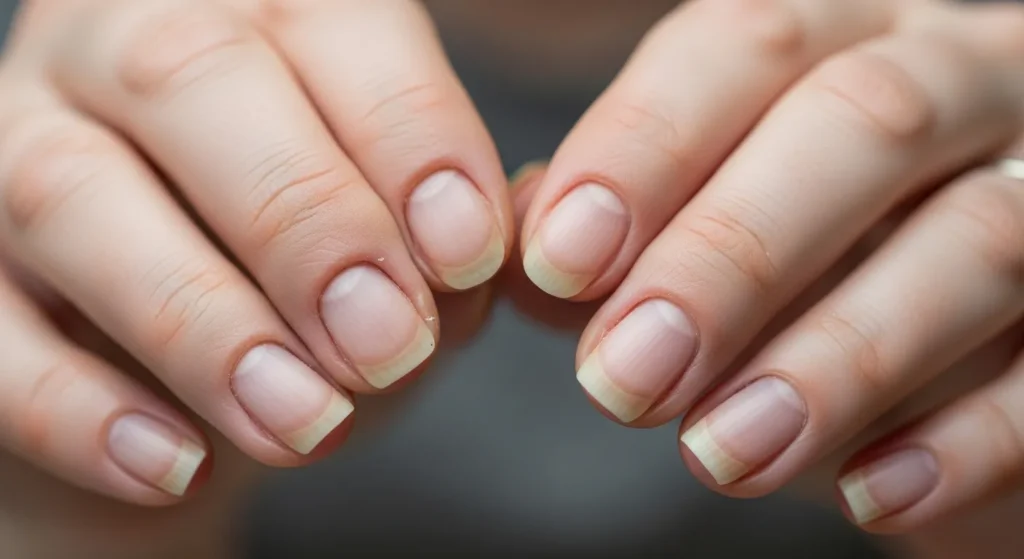Fragile nails and hair loss can be frustrating, especially when they happen at the same time. These issues often share a root cause, whether it’s a nutrient deficiency, hormonal imbalance, or lifestyle factor.
In this guide, you’ll discover the most common reasons behind weak nails and thinning hair, learn expert-approved solutions, and understand realistic recovery timelines.
By the end, you’ll know which changes you can make at home, when to see a doctor, and how to restore healthy growth with confidence.
Understanding Fragile Nails and Hair Loss

Why the Link? The Keratin Connection
Hair and nails are made primarily of keratin, a structural protein that gives them strength and resilience. When your body isn’t producing or maintaining healthy keratin, both your nails and hair can weaken at the same time.
Keratin production depends on:
- Adequate protein intake
- Balanced vitamins and minerals (especially biotin, iron, zinc)
- Healthy hormonal function
When any of these are disrupted, nails may split or peel, and hair may thin or shed more quickly.
Key Symptoms to Watch For
- Nails: splitting, peeling, slow growth, ridges, discoloration
- Hair: thinning at the crown, increased shedding, lack of shine
- Accompanying signs: fatigue, dry skin, scalp irritation
Common Causes
Nutrient Deficiencies
Lack of certain nutrients directly affects keratin production:
- Biotin – Vital for keratin synthesis. Deficiency can cause brittle nails and hair loss.
- Iron – Low iron/ferritin reduces oxygen delivery to follicles and nail beds.
- Protein – Essential for structural repair and growth.
- Omega-3 fatty acids – Keep nails and hair hydrated from within.
Pro Tip: A simple blood test can detect low iron or vitamin levels.
Hormonal Imbalances
- Thyroid disorders – Hypothyroidism often causes slow hair and nail growth.
- Menopause/perimenopause – Estrogen decline can make both hair and nails thinner.
- PCOS – Hormonal fluctuations affect growth cycles.
Medical Conditions
- Alopecia areata – An Autoimmune condition that can also cause nail pitting.
- Psoriasis – May affect nails and cause scalp hair loss.
- Fungal infections – Damage both nail plates and hair follicles if left untreated.
Lifestyle & Environmental Factors
- Frequent use of harsh nail polish removers or bleach
- Overuse of heat styling tools
- Chronic stress (triggers telogen effluvium)
- Repeated wet-dry cycles without protection
Timeline Chart: Nail & Hair Regrowth
| Timeframe | Nails | Hair |
|---|---|---|
| 1–3 months | Reduced breakage | Less shedding |
| 4–6 months | Stronger nails | Visible regrowth |
| 6–12 months | Full nail length restored | Density improvement |
At-Home Solutions & Nutritional Protocol
Diet Must-Haves
- Protein: Eggs, lean meats, lentils
- Iron: Spinach, red meat, fortified cereals
- Omega-3s: Salmon, chia seeds, walnuts
- Zinc: Pumpkin seeds, shellfish
Supplements: When to Use Them
- Biotin (2.5–5 mg/day) for brittle nails—only if deficient
- Iron supplementation based on ferritin levels
- Always choose third-party tested brands for purity and dosage accuracy
Lifestyle Updates
- Drink at least 2 liters of water daily
- Use gloves for dishwashing and cleaning
- Reduce stress through yoga or meditation
- Limit chemical hair treatments
Nail & Hair Care Routines
Nail Care Do’s and Don’ts
Do:
- Apply cuticle oil daily
- File in one direction only
- Use non-acetone removers
Don’t:
- Bite or pick at nails
- Peel off gel polish
Hair Care Best Practices
- Wash with sulfate-free shampoos
- Avoid daily heat styling
- Use silk pillowcases to reduce friction
Protective Habits
- Wear gloves for wet chores
- Avoid prolonged exposure to chlorinated water
- Keep nails short to prevent snagging
When to See a Specialist
Red Flags
- Suddenly, patchy hair loss
- Nails with severe ridging, pitting, or discoloration
- Accompanying symptoms like fatigue, weight changes, or joint pain
What Tests to Ask For
- Complete blood count (CBC)
- Ferritin, iron, and vitamin D
- Thyroid function tests (TSH, T4)
- Autoimmune screening if indicated
Medical Interventions
- Topicals: Minoxidil for hair loss
- Orals: Hormone therapy for menopausal women
- In-office: PRP therapy, laser treatments

Recovery Timeline & What to Expect
Nail Growth Chart (6–12 Months)
Nails grow 3 mm per month—visible changes may take 3–6 months.
Hair Growth Benchmarks (3–6 Months)
Hair grows ~1 cm per month; regrowth from shedding is often noticeable by month 4.
Fragile Nails and Hair Loss FAQs
Q1: Can stress cause both hair loss and nail fragility?
Yes—stress disrupts growth cycles and can trigger brittle nails and hair shedding.
Q2: How long does it take to see results from biotin?
If you’re deficient, improvements in nails can appear within 2–3 months.
Q3: Should I see a dermatologist or GP first?
Start with your GP for basic labs; a dermatologist can address specific skin, hair, and nail concerns.
Q4: Are brittle nails and hair loss always connected?
Not always—but when they occur together, systemic causes are more likely.
Next Steps
Fragile nails and hair loss often signal an underlying nutritional, hormonal, or medical issue. By identifying the cause early, making targeted lifestyle changes, and seeking expert advice when needed, you can restore both strength and growth.
Ready to restore your hair and nail health?
Book a consultation with Dr. Rana Irfan in Islamabad today for a personalized diagnosis and treatment plan tailored to your needs.
